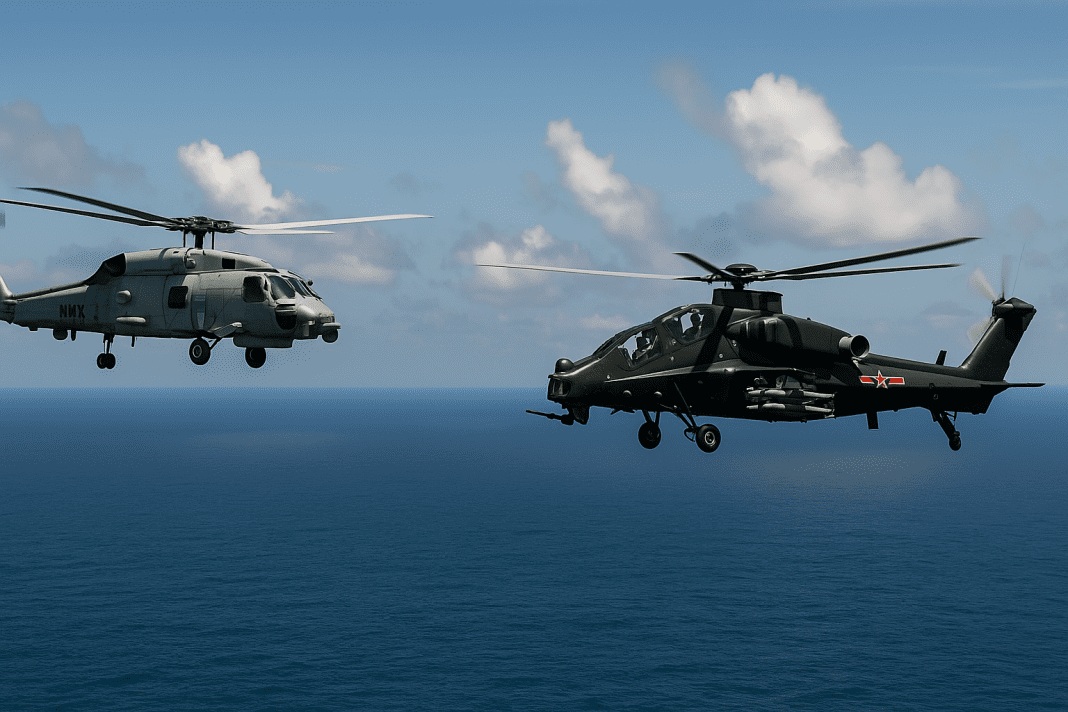A new video aired by Chinese state television has shown what they are calling a “high-stakes aerial standoff.”
A Dangerous Encounter in the Air
The footage claims to show a Chinese military helicopter intercepting a foreign aircraft that had come close to China’s coast. The foreign aircraft is believed to be a U.S. Navy MH-60R Seahawk helicopter.
The interception reportedly happened over the Taiwan Strait, a narrow waterway that separates mainland China from the island of Taiwan. The Chinese military did not confirm the exact date of the event, but they said the helicopter was moving near Chinese airspace. The U.S. Navy has not responded to the footage so far.
The video showed a Chinese Z-10 attack helicopter coming close to what looked like the U.S.-made Seahawk. The two helicopters appeared to circle each other for about an hour, with the Chinese pilot claiming the foreign helicopter came within three miles of China’s territorial waters. At one point, the Seahawk disappeared into clouds and then came back, approaching the Chinese helicopter from the left before turning away at a distance of around 500 meters.
Great Wall of Mistrust—China Warns NATO Against ‘Security Anxiety’ and Blame Games
Chinese media claimed the maneuver by the foreign aircraft was aggressive. They praised their pilot for warning the helicopter multiple times and eventually forcing it to leave the area.
The footage was aired on August 1, which is the anniversary of the founding of China’s military. This added a symbolic message of strength during a time when tensions in the region are high.
Taiwan Strait: The Center of Air and Sea Tensions
The Taiwan Strait has become a hotspot for military activity. China claims Taiwan and the waters around it, including parts of the strait. But the United States and its allies say those waters are international and open to all. This difference in opinion has led to many close calls in the air and at sea.
The Seahawk helicopter shown in the video is widely used by the U.S. Navy. It can do many things — search for submarines, track enemy ships, perform rescues, and carry supplies. These helicopters are launched from large ships like destroyers and aircraft carriers. Only the U.S. and South Korea operate the MH-60R Seahawk in the region, and South Korea’s helicopters aren’t active yet, making it likely that the one intercepted belonged to the United States.
The Chinese pilot in the video identified himself as part of the army’s aviation forces. That points to the helicopter being from China’s Eastern Theater Command, which is responsible for the area near Taiwan. Unlike China’s navy helicopters, the Z-10 is operated by the ground forces and is made for attack missions.
Over the past few years, the U.S. has continued to fly and sail military equipment through the Taiwan Strait. These actions are part of what the U.S. calls “freedom of navigation” operations. According to international law, military vessels are allowed to pass through these waters if they follow certain rules, like not launching weapons or aircraft during the trip. China, however, sees these missions as threats.
China has not declared the Taiwan Strait as internal waters, meaning they have not tried to block international shipping entirely. But they still demand that foreign militaries stay out, especially near their claimed territories.
China Warns Canada Over Warship Passage Through Taiwan Strait
Growing Number of Close Calls in 2025
This new helicopter incident adds to a series of tense encounters that have happened in 2025. Back in June, China reacted strongly when dozens of its planes reportedly crossed a middle line in the Taiwan Strait. This was around the same time British and Japanese navy ships were moving through the area, and U.S. lawmakers had visited Taiwan.
In February, a Chinese Navy Z-9 helicopter came very close to a Philippine surveillance aircraft. The plane, carrying journalists, was flying over the South China Sea near a disputed area called Scarborough Shoal. The helicopter got as close as three meters — an extremely risky distance. The Philippines called it a dangerous move, and the U.S. ambassador to Manila condemned it.
In May, Chinese state TV reported that in just 10 days, there were 11 helicopter face-offs with foreign militaries over the East China Sea. Some of the encounters were so close that the helicopters came within just 10 meters of each other. China did not name the countries involved but said these were provocations.
Then in July, there were more confrontations — this time between China and Japan. Both countries blamed each other for risky flying. China accused Japanese planes of entering its air defense zone, while Japan said Chinese fighter jets came dangerously close to one of its surveillance aircraft two days in a row.
Meanwhile, the U.S. Navy continues to conduct operations in the Taiwan Strait. Their ships and aircraft make regular trips through the area to challenge China’s broad maritime claims. One example is the USS William P. Lawrence, a U.S. Navy destroyer that sailed through the strait in April. This type of ship can carry two Seahawk helicopters, just like the one shown in the Chinese footage.
China Warns Germany of Escalating Mistrust Amid Spying Allegations
In early July, a ship entered the Taiwan Strait and identified itself as a U.S. government vessel. The U.S. Navy said no official Navy ship was involved at the time, adding more confusion about the activity in the region.
Even though each of these events may seem small, together they show a rising level of tension between China and other countries in the region. Whether in the air or at sea, each side continues to patrol and defend what it believes is its territory. As a result, the risk of accidents or miscommunication grows with every close encounter.

